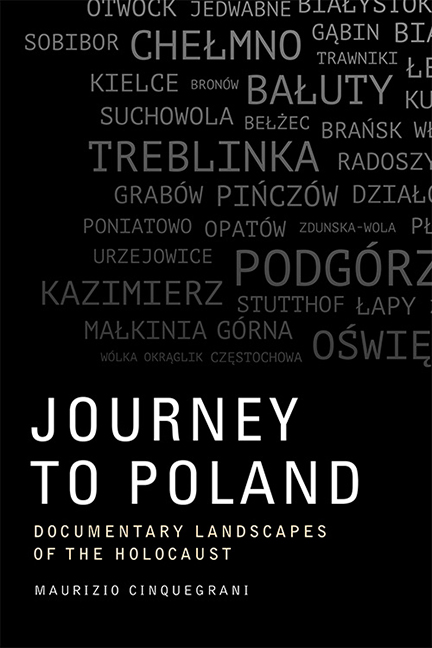Book contents
- Frontmatter
- Contents
- List of Figures
- Acknowledgements
- Dedication
- Prologue: Space, Time and the Holocaust
- 1 Countryside, Shtetl, City: The Murders of Mazovia, Jedwabne and Kielce
- 2 Conflicting Memories in the Shtetlekh Gąbin, Suchowola, Brańsk and Luboml
- 3 The Marketplaces of Postmemory in the Shtetlekh Eishyshok, Delatyn, Opatów, Zdunska Wola, Urzejowice and Pińczów
- 4 A Tale of Two Cities: Warsaw and Kraków
- 5 Another Tale of Two Cities: Lviv and Łódź
- 6 A Tale of Two Cities of Death: Treblinka and Oświęcim
- Epilogue: New Routes
- Bibliography
- Filmography
- Index
Prologue: Space, Time and the Holocaust
Published online by Cambridge University Press: 10 November 2020
- Frontmatter
- Contents
- List of Figures
- Acknowledgements
- Dedication
- Prologue: Space, Time and the Holocaust
- 1 Countryside, Shtetl, City: The Murders of Mazovia, Jedwabne and Kielce
- 2 Conflicting Memories in the Shtetlekh Gąbin, Suchowola, Brańsk and Luboml
- 3 The Marketplaces of Postmemory in the Shtetlekh Eishyshok, Delatyn, Opatów, Zdunska Wola, Urzejowice and Pińczów
- 4 A Tale of Two Cities: Warsaw and Kraków
- 5 Another Tale of Two Cities: Lviv and Łódź
- 6 A Tale of Two Cities of Death: Treblinka and Oświęcim
- Epilogue: New Routes
- Bibliography
- Filmography
- Index
Summary
In the autumn of 1941 the SS released orders for the construction of two large labour camps for Soviet prisoners of war to be built on the outskirts of the city of Lublin, in Lesser Poland, and in the village of Brzezinka, near Oświęcim, in Silesia. The barracks and compounds in the Konzentrationslager Majdanek and Auschwitz II-Birkenau would eventually resemble those of forced labour camps in the territories of the Reich, including Neuengamme, Mauthausen, Buchenwald, Sachsenhousen, Gross-Rosen and Flossenbürg. There was hardly anything to suggest that both camps would soon be turned into systematic killing tools for what the Nazis called the Final Solution of the Jewish Question. In the months that saw the construction of Majdanek and Auschwitz II-Birkenau, the Jews of Poland were being concentrated in the ghettos and exploited for manual labour. The establishment of these POW camps is unlikely to have been seen by the Jews as a development which would have an impact on their lives. While further east the Nazis had already obliterated hundreds of communities – and despite the fact that early accounts of the executions in Ponary and Chełmno had just reached Warsaw – the idea that both camps would soon combine forced labour with the mass killing of civilians, as well as the fact that camps solely devoted to the latter purpose were about to be built, was still unthinkable. And yet, in less than four years from the creation of Majdanek and Auschwitz II-Birkenau, surviving Polish Jews would emerge from the ruins of Warsaw, from barns and other shelters in rural areas and from the barracks of the camps liberated by the Allies, to face the complete annihilation of their world and the extermination of their people. Most of these survivors left Poland and never went back; some eventually returned to the wreckage of their homes and told their stories; all were irreparably damaged.
Documentary cinema has captured many of these journeys, and has explored a broader range of visits to sites of Jewish life and death invested with different meanings for each category of traveller. As the war catches up with them and tears open old wounds, Jews who return to Poland in search of things past are bound to experience a sense of anguish, loss and displacement in a journey through time and space to a place at once alien and familiar.
- Type
- Chapter
- Information
- Journey to PolandDocumentary Landscapes of the Holocaust, pp. 1 - 20Publisher: Edinburgh University PressPrint publication year: 2018



